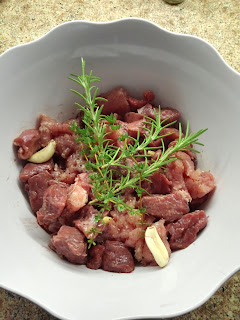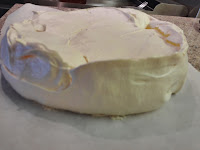Is it just me, or is making the turkey sort of a dreaded task? Either you know you're just setting out to force twenty pounds of dry and/or greasy bird on friends and family, or, if you're like me, you pretty much know you got assigned to turkey duty because no one else wants to take the blame if it sucks.
Well, suck this, turkey haters. Orange-Rosemary Turkey will never fail you. My dad found this recipe in
Bon Appetit in the '90s, and we've used it every year since in some variation. No lie. When I get to the homestead next week, I will take a picture of the well-worn, dog-eared, spattered copy that is kept with the cookbooks. Here's a link to the original
recipe. This post will be without a whole lot of pics, which I will take next week to update, but I really felt like it was more important to help save your bird this year, if you belong to a family whose bird is in need of saving. You know who you are. (Allow me to wax poetic here for a moment. Even if you just run down to Wal Mart and grab whatever frozen bird they have there, it's still an animal. One that probably led a pretty s@#tty life until it was sacrificed for your table. I strongly believe that if an animal gives up its life so we can eat it, we owe that animal the best preparation we can muster.)

Hence this simple but delightful turkey makeover. I like to vary this up a little bit, however. Personally, I think you need to make about double the Rosemary-Orange butter. I tend to stuff more butter in the turkey than this recipe calls for, plus you want some left over for dressing, gravy, and dinner rolls. Because once you taste it, you'll want to smear it on anything that will stand still. Thank goodness, your turkey is probably standing still.
 |
| This little tool is the easiest way to get pretty consistent orange or lemon zest. You can then chop with a knife if you want it in smaller pieces. |
So double the butter recipe described in the original. I usually add a bit of black pepper to my butter. This year I also added some frozen grated ginger as well. Mix this up the night before, divide in half (so you have a designated turkey bowl and and everything else bowl. No salmonella for us this year, thank you very much), and refrigerate. You can even make this two days in advance.
On the day you're cooking your turkey, **GET THE BUTTER OUT OF THE FRIDGE EARLY.** It's a lot easier to stuff the bird with room-temperature butter. And don't lose your mind and microwave the butter to soften it, because it also sucks to try to stuff your bird with completely melted butter.
 |
| My parents have seriously held onto this magazine since 1989. |
A note on turkeys. There's no sacred Thanksgiving writ that says you have to cook a whole bird if you have a small number of people, no one eats dark meat, or you're having multiple proteins. You can easily just buy and prepare the breast if you like. I usually do this at least once between Thanksgiving and Christmas when, inevitably, my husband casts sad eyes at me and says, "I really didn't get much turkey this year. I don't feel fully satisfied in the turkey department." This is not a dirty metaphor; he just wants me to cook another turkey. So I make him a breast, and everyone is happy.
So here we go. You've made your double batch of butter a day or two in advance to let the flavors meld together. You've taken it out of the fridge to warm to room temp. Now, to prep that turkey. I hope, if you bought a frozen turkey, that it's been thawing in the fridge for a couple of days. If not, you may want to put it in a sink of cold (NOT HOT) water to defrost.
When it's defrosted, remove the neck and giblets. You can use these in gravy, if that's how your family rolls, or you can make an excellent stock from them. However, if your turkey comes with a package of pre-made gravy frozen up in there, do your family a great service AND THROW THAT PAP AWAY IMMEDIATELY. Don't even handle it too much, lest you get bad cooking juju on you. Rinse your turkey well. Leave in that little thermometer button that pops out when it's cooking. You don't want to use this to measure when the turkey is done, but you don't want to leave a gaping hole for the juices to run out of either. Make sure you pull out any stray feather ends that may have been left behind.
 |
| I stuffed that giant turkey until, as Stanley Tucci said in Julie and Julia, "she just couldn't take it anymore." |
Now for the fun part. I'd roll my sleeves up and remove jewelry if I were you. First, you need to gently separate the skin from the muscle of the turkey without shredding it. Slowly and gently, work your fingers in between the skin and muscle, loosening the skin without tearing it. Loosen the skin all over. When you're done, stuff 3/4 of the bowl of turkey butter (so 3/4 of 1/2 of what you made) under the skin, smooshing it around until it's fairly evenly distributed. Then spread the remainder on top of the bird all over the skin to make it crunchy. Stuff the cavity full of onion, garlic (you can just take a whole head, cut it in half through all the cloves to expose them), celery (use the leaves! They're more flavorful than the stalk!), carrots, orange wedges. and rosemary. Make sure your turkey is elevated on a rack.
A note on dressing versus stuffing. "Dressing" is served on the side; "stuffing" is actually stuffed in the turkey to cook. I'm in the anti-stuffing camp. You really have to be careful to make sure the stuffing is heated to a high enough temp so as to not poison everyone with raw-bird juices, and usually, by the time the stuffing is cooked, the bird is overcooked (your stuffing must reach 160 degrees F). I'm not a fan, though I know some people who swear by stuffing and do it well.
Do tuck in the wings so your bird cooks evenly and no floppy bits incinerate in the oven, but don't worry about trussing. It takes longer to cook a trussed bird, and then the breast is dry.
A note on cooking turkey. This is not an all-day event unless you've stuffed it. It's usually a 2-3 hour event AT MOST, depending on how large your bird is. A breast will take less than half that time.
 |
| We had a little disaster with the convection oven being too hot, but we figured it out in time to save the bird. Next time, I think I'll take my blow torch to get a nice, even golden color. |
Your breast meat needs to reach 150 degrees, and the leg meat (it has more connective tissue) needs to hit 160 degrees to be safely done without being overdone. Use a thermometer rather than relying on a set amount of time. Let the turkey warm to room temp before cooking. It will cook more evenly that way. You want to start at a high heat to kill all the surface bacteria and brown the skin, loosely tent some foil over the breast so it doesn't brown further, and then lower the heat for the rest of the cooking time. When I lower the heat, I add a couple of cups each of water and white wine for moisture and to keep my drippings from burning. We usually start ours at 375 degrees until the breast is browned and then reduce the temp to a little less than 325 degrees for the rest of the cooking. But you know what? Screwing up the turkey isn't the end of the world. I accidentally cooked the turkey breast down the entire time one year, and it was awesomely tender. It didn't look pretty, but it was juicy. Undercooked turkey? Slice it and put it in a pan in its own juices to finish cooking it. Overcooked turkey? Slice it and put it in a pan in its own juices over super low heat. Pour your guests another round, and let them eat cake. Or pie.
Another note on cooking turkey. Put the baster down. All it does is make
that lovely, crunchy skin soggy. If you don't overcook the turkey and
you let it rest for at least ten minutes, it will be juicy.
I don't usually brine my turkeys because I really like to use the drippings, and the drippings from a brined turkey are too salty. To make gravy: in a pot, add 3T Rosemary Orange butter and/or drippings. Let it melt. Whisk in 3T (maybe a bit more) flour to make a roux. Let it cook a minute to get the flour taste out. Slowly,whisk in about 2 cups stock. As you start whisking, it will look like crap, but eventually, it will even out (sprinkle flour, don't dump in one place, and don't use cold flour to prevent clumping).
Another fun thing you can do is make pretty butter for the rolls.
 |
| Use a pastry bag to pipe pretty butter shapes onto parchment paper. |
|
Pipe some of your fancy Rosemary-Orange butter onto parchment paper and put it in the freezer to set. Arrange it on a plate and set out on the table for buttering rolls.

























 .
.



























